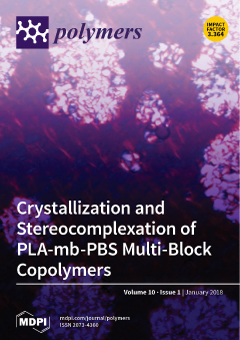In this study, we investigated the aggregation behaviors of amphiphilic poly(vinyl ether)s with antimicrobial activity. We synthesized a di-block poly(vinyl ether), B38
26, composed of cationic primary amine and hydrophobic isobutyl (
iBu) side chains, which previously showed antimicrobial activity against
[...] Read more.
In this study, we investigated the aggregation behaviors of amphiphilic poly(vinyl ether)s with antimicrobial activity. We synthesized a di-block poly(vinyl ether), B38
26, composed of cationic primary amine and hydrophobic isobutyl (
iBu) side chains, which previously showed antimicrobial activity against
Escherichia coli. B38
26 showed similar uptake behaviors as those for a hydrophobic fluorescent dye, 1,6-diphenyl-1,3,5-hexatriene, to counterpart polymers including homopolymer H44 and random copolymer R40
25, indicating that the
iBu block does not form strong hydrophobic domains. The cryo-TEM observations also indicated that the polymer aggregate of B38
26 appears to have low-density polymer chains without any defined microscopic structures. We speculate that B38
26 formed large aggregates by liquid-liquid separation due to the weak association of polymer chains. The fluorescence microscopy images showed that B38
26 bonds to
E. coli cell surfaces, and these bacterial cells were stained by propidium iodide, indicating that the cell membranes were significantly damaged. The results suggest that block copolymers may provide a new platform to design and develop antimicrobial materials that can utilize assembled structures and properties.
Full article






